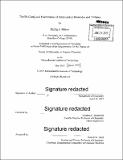The Pd-catalyzed fluorination of (hetero)aryl bromides and triflates
Author(s)
Milner, Phillip J
DownloadFull printable version (44.17Mb)
Other Contributors
Massachusetts Institute of Technology. Department of Chemistry.
Advisor
Stephen L. Buchwald.
Terms of use
Metadata
Show full item recordAbstract
Chapter 1: This chapter details mechanistic work regarding the reductive elimination of electron-rich aryl fluorides from L-Pd(Ar)F species. An unexpected dearomatization/arylation process of Pd(II) complexes bearing bulky biaryl phosphines was discovered, resulting in ligand arylation during the catalytic fluorination of aryl triflates. This process must occur prior to C-F reductive elimination. Further experimental studies of this rearrangement revealed that it likely proceeds via a concerted migratory insertion into the bottom ring of the ligand. Chapter 2: This chapter describes extensive work to understand the mechanism by which regioisomeric mixtures of products form during the Pd-catalyzed fluorination of electron-rich aryl triflates lacking ortho-substituents. Deuterium labeling experiments suggest that ortho-deprotonation of L-Pd(Ar)OTf intermediates by CsF competes with the transmetallation step of the desired catalytic process. Additional studies investigating the previously observed formation of regioisomeric products in the absence of CsF (Chapter 1) are also presented. Chapter 3: This chapter describes the key discovery that di-adamantyl ligands are superior to tBuBrettPhos for promoting the Pd-catalyzed fluorination of aryl triflates. While previously described 2-aminobiphenyl-based sulfonate precatalysts were ineffective, readily activated [(L-Pd) 2COD] (COD = cyclooctadiene) complexes proved to be general precatalysts for these reactions. Further structural and reactivity studies of this new family of precatalysts are presented. Chapter 4: The first general method for the Pd-catalyzed fluorination of aryl bromides and iodides is described using a combination of AgF and various additives, most commonly KF. Preliminary studies suggest that the additive is necessary to promote an otherwise difficult transmetallation step. In addition, the use of a "pre-modified" ligand, HGPhos, allows for the Pd-catalyzed fluorination of 6-membered nitrogen-containing heterocycles. An investigation of ligand structural effects on this reaction is also included. Chapter 5: An in-depth investigation of the Pd-catalyzed fluorination of 5-membered heteroaryl bromides is described. Preliminary crystallographic and computational evidence suggest that reductive elimination of 5-membered heteroaryl fluorides from Pd(II) is extremely difficult. Nonetheless, it was found that heteroaryl bromides bearing ortho-phenyl groups, as well as highly activated 2-bromoazoles, can be efficiently fluorinated using a catalyst based on the recently developed ligand AlPhos.
Description
Thesis: Ph. D. in Organic Chemistry, Massachusetts Institute of Technology, Department of Chemistry, 2015. Cataloged from PDF version of thesis. Includes bibliographical references.
Date issued
2015Department
Massachusetts Institute of Technology. Department of ChemistryPublisher
Massachusetts Institute of Technology
Keywords
Chemistry.